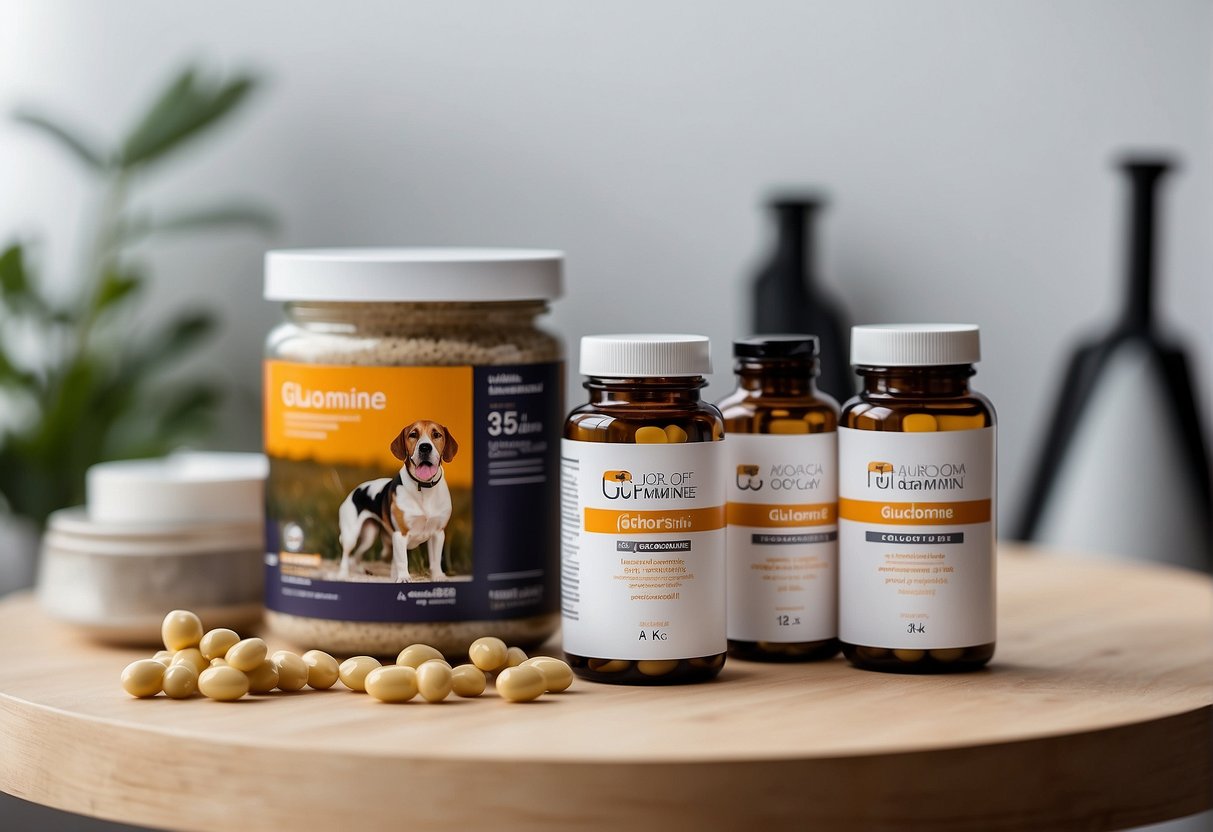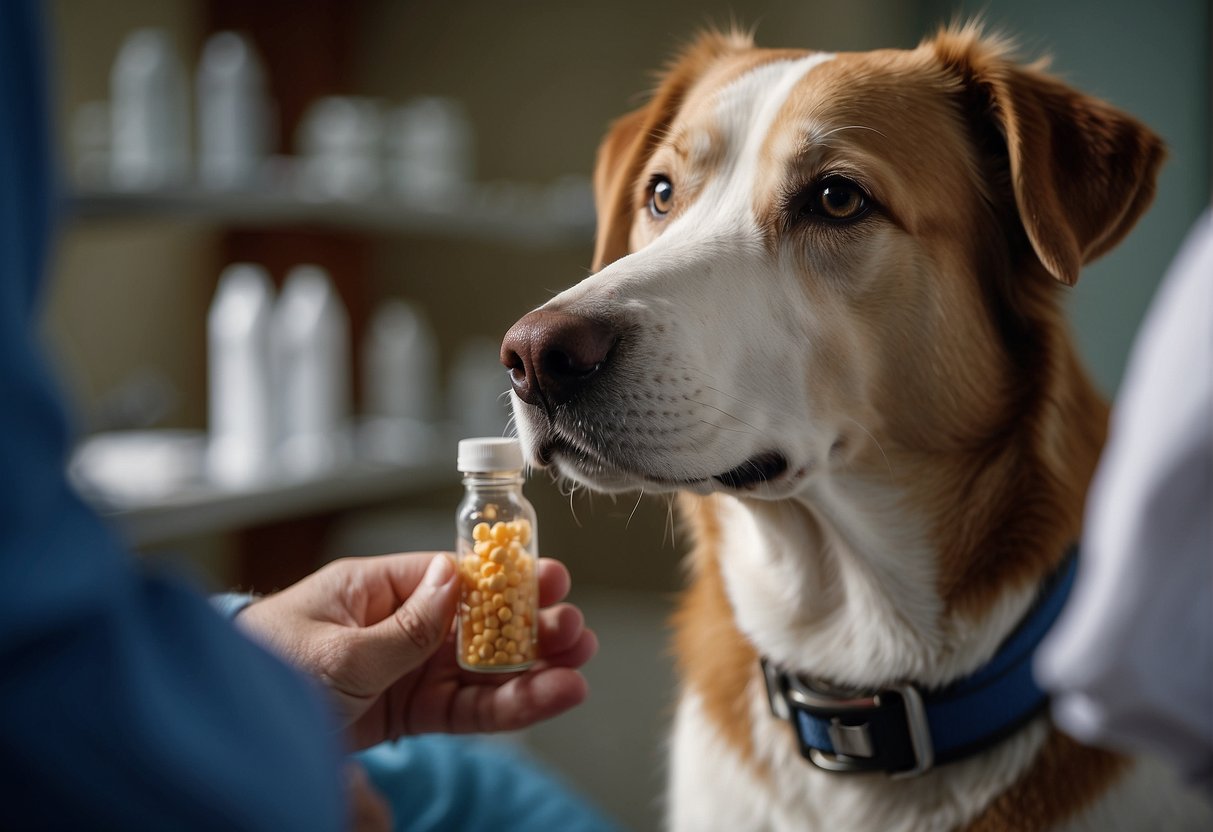As pet owners, we always want to ensure our furry friends are happy and healthy.
Joint pain can significantly affect a dog’s quality of life, which is why many of us turn to supplements that can provide relief.
Glucosamine and chondroitin have become popular choices for supporting canine joint health.
These supplements are known for their role in maintaining cartilage and joint function, offering a way to manage arthritis and joint wear, which can be particularly prevalent as dogs age.

Understanding what glucosamine and chondroitin are and how they could benefit our dogs is key to making informed decisions about their care.
Glucosamine is a natural compound found in the body, renowned for its ability to repair and maintain cartilage.
Chondroitin works in tandem with glucosamine, helping to maintain the integrity of joints and promote overall mobility and flexibility in our canine companions.
We’ve looked into the benefits and dosages of glucosamine for dogs, exploring how these components can play a crucial role in managing joint health issues.
While no supplement is a cure-all, integrating glucosamine and chondroitin into our dogs’ diets, with a vet’s recommendation, could potentially provide them with the extra support they need to live active and comfortable lives.
Understanding Glucosamine and Chondroitin

Glucosamine and chondroitin are critical to maintaining our dogs’ joint health.
They play a vital role in nurturing and repairing cartilage, the essential cushion within their joints.
The Role of Glucosamine in Canine Health
Glucosamine sulfate is a naturally occurring chemical found in our dogs’ bodies, with high concentrations in their joint tissues.
It’s vital for building and repairing cartilage, ensuring the smooth operation of joints.
As an anti-inflammatory agent, glucosamine also helps to alleviate the pain that comes from joint disorders.
The Benefits of Chondroitin for Dogs
Chondroitin sulfate complements glucosamine and is naturally found in the cartilage.
It’s crucial for maintaining the structural integrity of this tissue by resisting compression.
This means with chondroitin, our furry friends’ joints are better cushioned against the stress of movement.
Different Forms of Glucosamine and Chondroitin Supplements
We find glucosamine and chondroitin in various forms like tablets, chews, liquids, or even as ingredients in some dog foods.
Chewables might come in flavors like duck to make them more appealing to our dogs.
It’s important to choose a high-quality supplement to ensure they provide the intended benefits to our dogs’ joint health.
Joint Health and Disease in Dogs

When we consider our dogs’ well-being, joint health is a crucial aspect we can’t overlook.
Joint problems can cause pain and affect our furry friends’ quality of life, but understanding these issues is the first step in managing their health effectively.
Common Joint Problems in Dogs
Two prevalent joint issues in dogs include osteoarthritis and hip dysplasia.
Osteoarthritis, also known as degenerative joint disease, is a common condition where the cartilage in the joints breaks down, causing pain and stiffness.
Hip dysplasia is a genetic condition where the hip joint does not form properly, which can lead to arthritis.
- Osteoarthritis: tends to affect older dogs but can occur at any age.
- Hip Dysplasia: often seen in larger breeds, it can lead to significant joint pain.
Recognizing Signs of Joint Diseases
It’s crucial for us to recognize the signs of joint diseases so we can take prompt action. These signs include:
- Stiffness, especially after rest
- Difficulty with movements like climbing stairs or jumping
- Limping or favoring one leg
- Visible pain during or after movement
- Swelling around the joints
If we notice these symptoms, it’s important for us to consult a veterinarian for a proper diagnosis and treatment plan.
Osteoarthritis and Hip Dysplasia
Osteoarthritis and hip dysplasia can seriously impact our dogs’ mobility and quality of life.
Osteoarthritis is the chronic deterioration of joints, while hip dysplasia is a malformation of the hip joint.
- Osteoarthritis:
- Chronic condition leading to loss of cartilage
- Impacts mobility and comfort
- Hip Dysplasia:
- Genetic disorder affecting hip joint formation
- Can lead to early onset osteoarthritis
Addressing these conditions often involves a combination of dietary management, exercise, and possibly medications to manage pain and inflammation.
Early intervention can improve outcomes for our dogs, allowing them to lead happier, more active lives.
Administering Glucosamine and Chondroitin

When we decide to give our dogs supplements like glucosamine and chondroitin, it’s imperative that we do it correctly to ensure their safety and well-being.
Getting the dosage right, incorporating it into their diet, and being aware of possible side effects are all crucial steps in this process.
Appropriate Dosage for Dogs
The dosage of glucosamine and chondroitin for dogs can vary based on their size, weight, and specific needs.
A common guideline is:
- Small dogs (under 25lbs): 250-500mg of glucosamine and about 200mg of chondroitin per day
- Medium dogs (25-50lbs): 500mg of glucosamine and 400mg of chondroitin per day
- Large dogs (50-100lbs): 1,000mg of glucosamine and 800mg of chondroitin per day
- Giant dogs (over 100lbs): 1,500mg of glucosamine and 1,200mg of chondroitin per day
Always consult a veterinarian to determine the right amount for your individual dog and to make adjustments for any specific health considerations.
Incorporating Supplements into Diet
We can introduce glucosamine and chondroitin into our dog’s diet in several ways.
They’re available in tablets, liquids, and powdered forms, or even as ingredients in some dog foods.
It’s often easiest to mix the supplement with their dog food to ensure they consume the full dosage.
If using tablets, consider them as treats or hide them in a favorite food to ensure your dog takes them.
Potential Side Effects and Considerations
While side effects from glucosamine and chondroitin are rare in dogs, they can include gastrointestinal upset, such as diarrhea or vomiting.
Be watchful for any signs of allergic reactions, especially if your dog has known allergies to shellfish, since many glucosamine supplements are derived from shellfish.
Before starting a supplement regimen, have your dog tested for allergies and discuss any concerns with your vet.
Observing your dog closely after administering the supplements can help catch any adverse reactions early.
Additional Support for Arthritic Dogs

Arthritic dogs often need more than just medication.
We’ll explore the role of lifestyle, complementary therapies, and the importance of regular vet visits in managing joint health.
The Impact of Lifestyle on Joint Health
A healthy lifestyle is crucial for managing arthritis in dogs.
This means we need to ensure our dogs maintain an optimal weight to lessen the load on their joints.
Regular, gentle exercise like walking or swimming can help keep their joints mobile, while excessive running or jumping might exacerbate joint pain.
Complementary Therapies and Nutraceuticals
Alongside glucosamine and chondroitin, other nutraceuticals like MSM (methylsulfonylmethane) and antioxidants may provide additional pain relief.
MSM in particular is believed to reduce inflammation, which plays a significant part in arthritic pain.
Natural compounds like boswellia have also been noted for their anti-inflammatory properties, which can be especially beneficial for dogs with osteoarthritis.
- MSM: May help decrease joint inflammation.
- Boswellia: Known as a natural anti-inflammatory agent.
- Antioxidants: Can assist in reducing oxidative damage in the joints.
Importance of Regular Veterinary Check-ups
We must not underestimate the importance of regular check-ups with a vet.
They can help us fine-tune our dog’s treatment plan, including the use of glucosamine and chondroitin supplements.
Consistent monitoring allows for adjustments in treatments and can help identify other areas where our dogs may need support.
Frequently Asked Questions About Glucosamine and Chondroitin for Dogs
We’ve compiled some frequently asked questions to help you navigate the topic of glucosamine and chondroitin supplements for your dog.
Understanding how to choose the right supplement, addressing concerns related to diabetes, and exploring alternatives can help you make informed decisions for your furry friend’s joint health.
Choosing the Best Glucosamine for Your Dog
When looking for the best glucosamine for dogs, consider products that contain glucosamine hydrochloride, as it’s a highly absorbable form of glucosamine.
Chewable tablets are popular for their ease of administration.
A recommended product might include ingredients like MSM and chondroitin for comprehensive joint support.
Addressing Concerns Over Glucosamine and Diabetes
It’s natural to be concerned about how glucosamine might affect your dog’s blood sugar, especially if they’re diabetic.
While studies suggest that glucosamine should not significantly impact blood sugar levels, always consult your vet when considering glucosamine supplements for a dog with diabetes.
Alternatives to Glucosamine and Chondroitin Supplements
If you’re seeking alternatives to glucosamine and chondroitin supplements, consider natural foods rich in omega-3 fatty acids such as fish oil, which may help maintain joint health.
Physical therapy and cushioned bedding can also support joints—with or without supplements like glucosamine.















